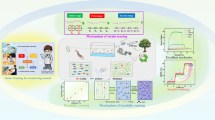Abstract
Regenerated silk fibroin solutions (RSF) are produced by dissolving degummed silk fibers in water. We have observed that RSF solutions at a concentration less than 15 % by weight exhibit an unusual gel-like response in conventional shear rheology measurements. At higher concentrations, the response is predominantly viscous (or liquid-like). We have probed this counterintuitive behavior of silk fibroin solutions by using microrheology, and interfacial rheometry. Scattering techniques were also used to understand the microstructure of RSF solutions as a function of the concentration. Our studies suggest that the gel-like response of the RSF solution may result from the formation of an interfacial film at the air–solution interface, which dominates the bulk rheological response.








Similar content being viewed by others
References
Baravian C, Benbelkacem G, Caton F (2007) Unsteady rheometry: can we characterize weak gels with a controlled stress rheometer? Rheol Acta 46:577–581. doi: 10.1016/j.polymer.2007.04.019
Crocker J, Grier D (1996) Methods of digital video microscopy for colloidal studies. J Colloid Interf Sci 179:298–310
Erni P, Fischer P, Windhab E, Kusnezov V, Stettin H, Lauger J (2003) Stress-and strain-controlled measurements of interfacial shear viscosity and viscoelasticity at liquid/liquid and gas/liquid interfaces. Rev Sci Instrum 74(11):4916–4924. doi: 10.1063/1.1614433
Ferry J (ed) (1980) Viscoelastic properties of polymers. Wiley, New York
Greving I, Dicko C, erry A, Callow P, Vollrath F (2010) Small-angle neutron scattering of native and reconstituted silk fibroin. Soft Matter 6:4389–4395. doi: 10.1039/c0sm00108b
Holland C, Terry A, Porter D, Vollrath F (2007) Natural and unnatural silks. Polymer 48:3388–3392. doi: 10.1007/s00397-006-0135-x
Hossain K, Nemoto N, Magoshi J (1999) Rheological study on aqueous solutions of silk fibroin extracted from the middle division of Bombyx mori silkworm. J Soc Rheol Jpn 27(2):129–130. doi: 10.1678/rheology.27.129
Ikeda S, Nishinari K (2001) On solid-like rheological behaviors of globular protein solutions. Food Hydrocoll 15:401–406
Inoue H, Matsumoto T (1996) Viscoelastic characterization of solid-like structure in aqueous colloids of globular proteins. Colloids Surf A Physicochem Eng Asp 109:89–96
Inoue S, Tanaka K, Arisaka F, Kimura S, Ohtomo K, Mizuno S (2000) Silk fibroin of Bombyx mori is secreted, assembling a highmolecular mass elementary unit consisting of H-chain, L-chain and P25, with a 6:6:1 molar ratio. J Biol Chem 275:40,517–40,528
Kragel J, Derkatch S, Miller R (2008) Interfacial shear rheology of protein-surfactant layers. Adv Colloid Interface Sci 144:38–53. doi: 10.1016/j.cis.2008.08.010
Lindner P, Zemb T (eds) (2002) Neutrons, X-rays and light: scattering methods applied to soft condensed matter. Elsevier
Matsumoto A, Chen J, Collette A, Kim U, Altman G, Cebe P, Kaplan D (2006) Mechanisms of silk fibroin sol-gel transitions. J Phys Chem B 110(43): 21,630–21,638
Mo C, Holland C, Porter D, Shao Z, Vollrath F (2009) Concentration state dependence of the rheological and structural properties of reconstituted silk. Biomacromolecules 10:2724–2728. doi: 10.1021/bm900452u
Muller W, Samuelson L, Fossey S, Kaplan D (1993) Formation and characterization of langmuir silk films. Langmuir 9:1857–1861
Nagarkar S, Patil A, Lele A, Bhat S, Bellare J, Mashelkar R (2009) Some mechanistic insights into the gelation of regenerated silk fibroin sol. Ind Eng Chem Res 48:8014–8023. doi: 10.1021/ie801723f
Ochi A, Hossain K, Magoshi J, Nemoto N (2002) Rheology and dynamic light scattering of silk fibroin solution extracted from the middle division of Bombyx mori silkworm. Biomacromolecules 3:1187–1196. doi: 10.1021/bm020056g
Oh S, Slattery J (1978) Disk and biconical interfacial rheometers. J Colloid Interfacial Sci 67(3):516–525
Omenetto F, Kaplan D (2010) New opportunities for an ancient material. Science 329:528–531
Raghu A, Somashekar R, Ananthamurthy S (2007) The crystal structure of Bombyx mori silk fibroin at air-water interface. J Polym Sci B Polym Phys 45:2555–2562
Sharma V, Jaishankar A, Wang Y, McKinley G (2011) Interfacial viscoelasticity, yielding and creep ringing of globular protein-surfactant mixtures. Soft Matter 7:5150–5160. doi: 10.1039/C1SM05399J
Shotton E, Wibberley K, Warburton B, David S, Finlay P (1971) A versatile surface rheometer. Rheol Acta 10:142–152
Vandebril S, Franck A, Fuller G, Moldenaers P, Vermant J (2010) A double wall-ring geometry for interfacial shear rheometry. Rheol Acta 49:131–144. doi: 10.1007/s00397-009-0407-3
Vepari C, Kaplan D (2007) Silk as a biomaterial. Prog Polym Sci 32:991–1007. doi: 10.1016/j.progpolymsci.2007.05.013
Waigh T (2005) Microrheology of complex fluids. Rep Prog Phys 68:685–742
Wang L, Xie H, Qiao X, Goffin A, Hodgkinson T, Yuan X, Sun K, Fuller G (2012) Interfacial rheology of natural silk fibroin at air/water and oil/water interfaces. Langmuir 28:459–467. doi: 10.1021/la2041373
Yang Y, Dicko C, Bain C, Gong Z, Jacobs R, Shao Z, Terry A, Vollrath F (2012) Behavior of silk protein at the air-water interface. Soft Matter 8:9705–9712
Zhou C, Confalonieri F, Jacquet M, Perasso R, Li Z, Janin J (2001) Silk fibroin: structural implications of a remarkable amino acid sequence. Proteins 44:119–122
Acknowledgments
AN thanks Dr. V. Aswal (BARC) for help with the SANS experiments. We thank CSRTI for generous supplies of B. mori cocoons.
Author information
Authors and Affiliations
Corresponding author
Rights and permissions
About this article
Cite this article
Nisal, A., Kalelkar, C., Bellare, J. et al. Rheology and microstructural studies of regenerated silk fibroin solutions. Rheol Acta 52, 833–840 (2013). https://doi.org/10.1007/s00397-013-0723-5
Received:
Revised:
Accepted:
Published:
Issue Date:
DOI: https://doi.org/10.1007/s00397-013-0723-5




